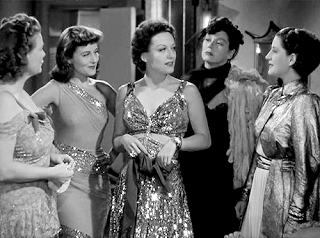
"A woman's compromised the day she's born!"
It's hard to approach The Women (1939), a "sophisticated" dramedy that's embarrassingly dated. George Cukor's film is easy to like for its all-female cast, a murder's row of iconic stars relishing Clare Booth Luce's barbed, catty dialog. Yet there's a dubious undercurrent that makes for uncomfortable viewing.Rich Manhattanite Mary Haines (Norma Shearer) discovers that her husband Stephen is having an affair with shop girl Crystal (Joan Crawford). Mary's cousin Sylvia (Rosalind Russell) spreads the news among Mary's social circle and into a gossip column, creating a public scandal. Mary tries divorcing Stephen and travels west to Reno, meeting up with a group of like-minded women who urge her to move on. Eventually however she decides to reclaim her man, fighting Crystal in a diva duel to the death.
The Women has all the delights you'd expect from a Golden Age "woman's picture." Luce's play is ably adapted by Anita Loos and Jane Murfin, allowing the actresses to savor its cutting barbs and witty putdowns. The cast's claws-out charisma matches well with Cukor's swank staging, creating a fantasy replete with elaborate, shimmering gowns and ornate settings. This culminates in an exquisitely shot Technicolor fashion show, inundating viewers in all the high fashion and womanly glamor they could imagine.
Unfortunately, this points up The Women's more repugnant traits. It reflects the snotty country club Republicanism that Luce and her husband embodied, treating wealth and luxury as humanity's ultimate achievement. Crystal's sin isn't her philandering with Stephen, but being a mere shop girl who dares sleep with a rich man. A threat to Mary and friends' social order, she must be destroyed. Lucy (Marjorie Martin), who runs a dude ranch without a husband, is marginally more sympathetic, yet seems a boorish nouveau riche whose friendship seems to mark just how low Mary's fallen.
Lest anyone view an all-woman cast as a feminist statement, Cukor's film seems repugnantly chauvinist. The credits charmingly superimpose the stars on the faces of animals, and The Women's gender politics don't get much better. Even our sympathetic characters fret about money, gossip about relationships and squabble over men, revealing themselves superficial, sharp-tongued meanies. Cukor limits small, human moments to Mary, explaining divorce to her daughter (Virginia Weidler), and nice girl Peggy (Joan Fontaine), worrying about her own relationship. Otherwise it's a feature length cat fight, with Mary's Jungle Red nail paint embodying feminine rage.
Which accounts for The Woman's enduring popularity in the first place. The cast of battling stars is in top form, with Norma Shearer's woman scorned and Rosalind Russel's snappy spitfire especially appealing. Joan Crawford is wonderful even if she seems miscast: it's hard to imagine someone some imperious and menacing as a lower class shop girl. Paulette Goddard plays a coarse chorus girl who gets into a kicking match with Russell; Joan Fontaine is one of the nicer characters on hand. Hedda Hopper has a cameo, essentially playing herself.
Most women's pictures from Classic Hollywood carry questionable messages that don't damage essentially harmless fantasies. The problem with The Woman is that its bilious classism comes baked into its snappy dialog and dueling stars, its driving force rather than an incidental annoyance. Viewers can decide on their own how much it harms the picture.

